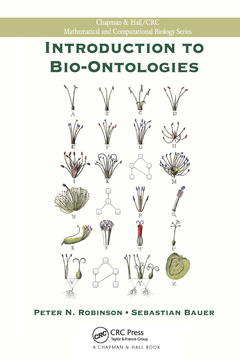Description
Introduction to Bio-Ontologies
Chapman & Hall/CRC Computational Biology Series
Authors: Robinson Peter N., Bauer Sebastian
Language: English
Subjects for Introduction to Bio-Ontologies:
Keywords
Obo; Overrepresentation Analysis; Bio-Ontologies; Owl Ontology; ontological algorithms; Annotation Propagation Rule; mathematical logic; GO; RDF; Bayesian Network; Entailment Rules; RDFS; Ontology Languages; OWL; Semantic Web; Gene Ontology; Biomedical Ontologies; Chemical Entities of Biological Interest; URI Reference; Human Phenotype Ontology; Inference Rule; graph-based algorithms; Biological Process Term; Molecular Function; semantic similarity analysis; Blank Nodes; Bayesian networks; Genes Annotated; molecular biology; Description Logics; biomedical data; W3C standards; Ubiquitin Ligase Complex; Study Set; inference algorithm; Semantic Similarity; SPARQL; RDF Data; bioinformatics; Basic Formal Ontology; molecular genetics; Phenotypic Abnormality; Mammalian Phenotype Ontology; SPARQL Query
56.31 €
In Print (Delivery period: 14 days).
Add to cartPublication date: 09-2020
· 15.6x23.4 cm · Paperback
129.87 €
In Print (Delivery period: 15 days).
Add to cartPublication date: 07-2011
488 p. · 15.6x23.4 cm · Hardback
Description
/li>Contents
/li>Readership
/li>Biography
/li>
Introduction to Bio-Ontologies explores the computational background of ontologies. Emphasizing computational and algorithmic issues surrounding bio-ontologies, this self-contained text helps readers understand ontological algorithms and their applications.
The first part of the book defines ontology and bio-ontologies. It also explains the importance of mathematical logic for understanding concepts of inference in bio-ontologies, discusses the probability and statistics topics necessary for understanding ontology algorithms, and describes ontology languages, including OBO (the preeminent language for bio-ontologies), RDF, RDFS, and OWL.
The second part covers significant bio-ontologies and their applications. The book presents the Gene Ontology; upper-level ontologies, such as the Basic Formal Ontology and the Relation Ontology; and current bio-ontologies, including several anatomy ontologies, Chemical Entities of Biological Interest, Sequence Ontology, Mammalian Phenotype Ontology, and Human Phenotype Ontology.
The third part of the text introduces the major graph-based algorithms for bio-ontologies. The authors discuss how these algorithms are used in overrepresentation analysis, model-based procedures, semantic similarity analysis, and Bayesian networks for molecular biology and biomedical applications.
With a focus on computational reasoning topics, the final part describes the ontology languages of the Semantic Web and their applications for inference. It covers the formal semantics of RDF and RDFS, OWL inference rules, a key inference algorithm, the SPARQL query language, and the state of the art for querying OWL ontologies.
Web ResourceSoftware and data designed to complement material in the text are available on the book?s website: http://bio-ontologies-book.org The site provides the R Robo package developed for the book, along with a compressed archive of data and ontology files used in some of the exercises. It also offers teaching/presentation slides and links to other relevant websites.
This book provides readers with the foundation to use ontologies as a starting point for new bioinformatics research projects or to support current molecular genetics research projects. By supplying a self-contained introduction to OBO ontologies and the Semantic Web, it bridges the gap between both fields and helps readers see what each can contribute to the analysis and understanding of biomedical data.
Basic Concepts: Ontologies and Applications of Ontologies in Biomedicine. Mathematical Logic and Inference. Probability Theory and Statistics for Bio-Ontologies. Ontology Languages. Bio-Ontologies: The Gene Ontology. Upper-Level Ontologies. A Selective Survey of Bio-Ontologies. Graph Algorithms for Bio-Ontologies: Overrepresentation Analysis. Model-Based Approaches to GO Analysis. Semantic Similarity. Frequency-Aware Bayesian Network Searches in Attribute Ontologies. Inference in Ontologies: Inference in the Gene Ontology. RDFS Semantics and Inference. Inference in OWL Ontologies. Algorithmic Foundations of Computational Inference. SPARQL. Appendices. Bibliography. Index.
Peter N. Robinson is a research scientist and leader of the Computational Biology Group in the Institute of Medical Genetics and Human Genetics at Charité-Universitätsmedizin Berlin. Dr. Robinson completed his medical education at the University of Pennsylvania, followed by an internship at Yale University. He also studied mathematics and computer science at Columbia University. His research interests involve the use of mathematical and bioinformatics models to understand biology and hereditary disease.
Sebastian Bauer is a research assistant in the Institute of Medical Genetics and Human Genetics at Charité-Universitätsmedizin Berlin. He earned a degree in computer science from the Technical University of Ilmenau. His research interests include mathematical modeling, discrete algorithms, theoretical computer science, software engineering, and the applications of these fields to medicine and biology.




